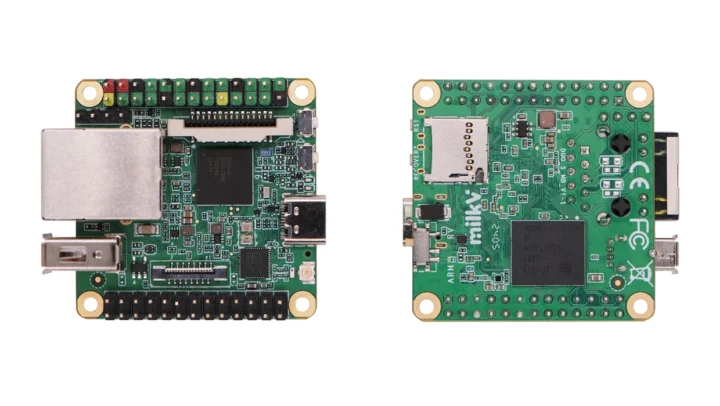Shenzhen MilkV Technology’s Duo S is a tiny SBC based on the 1 GHz Sophgo SG2000 Arm Cortex-A53 and RISC-V SoC with 512MB DDR3 (SiP), Fast Ethernet, WiFi 6, and Bluetooth 5 connectivity, and a switch to select Arm or RISC-V architecture before powering the board.
We already had covered SG2002 Arm/RISC-V boards with 256MB RAM, namely the LicheeRV Nano and Duo 256M, but for people needing more memory, the Duo S provides another option that also features two 2-lane MIPI CSI connectors, a USB 2.0 host port, and two 26-pin headers for expansion. Its form factor reminds me of FriendlyELEC’s NanoPi NEO and family powered by Allwinner processors that were introduced a few years ago.
Duo S specifications:
- SoC – SOPHGO SG2000
- Main core – 1 GHz 64-bit RISC-V C906 or Arm Cortex-A53 core (selectable)
- Minor core – 700 MHz 64-bit RISC-V C906 core
- Low-power core – 25 to 300 MHz 8051 MCU core with 8KB SRAM
- NPU – 0.5 TOPS INT8, supports BF16
- Integrated 512MB DDR3 (SiP)
- Storage
- MicroSD card slot
- Optional 8GB eMMC flash
- Display – 4-lane MIPI DSI via GPIO header
- Camera Interfaces
- 16-pin FPC connector for 2-lane MIPI CSI
- 15-pin FPC connector for 2-lane MIPI CSI
- Support for 5MP camera sensors
- Audio – Built-in microphone
- Networking
- 100Mbps Ethernet RJ45 jack with optional PoE support via expansion board
- Optional WiFi 6 and Bluetooth 5
- USB – 1x USB Type-C port for power and programming, 1x USB 2.0 host port (Note: USB-C and USB 2.0 ports are multiplexed, so only one can be used at a time)
- Expansion – 2x 26-pin 2.54 pitch headers with access to up to 39x GPIO, PWM, I2C, SPI, UART, MIPI DSI, JTAG, SD, Audio, power signals
- Debugging – 4-pin UART header
- Misc – BOOT Switch (Arm vs RISC-V selection), Recovery Key, Reset Key
- Power Supply – 5V via USB-C port
- Dimensions – 43 x 43mm
 Linux and RTOS are said to be supported on the Duo S, and you’ll find buildroot-built OS images on GitHub to boot from either the microSD card or the eMMC flash. As of the current v1.0.9 image, Duo S does not yet support wiringX (C) and pinpong (Python) GPIO libraries, and Arduino support is not implemented either. The latter means the board will eventually be programmable like a microcontroller using the Arduino IDE as is already possible on the Duo 256M with SG2002. Some instructions to get started can be found in the wiki.
Linux and RTOS are said to be supported on the Duo S, and you’ll find buildroot-built OS images on GitHub to boot from either the microSD card or the eMMC flash. As of the current v1.0.9 image, Duo S does not yet support wiringX (C) and pinpong (Python) GPIO libraries, and Arduino support is not implemented either. The latter means the board will eventually be programmable like a microcontroller using the Arduino IDE as is already possible on the Duo 256M with SG2002. Some instructions to get started can be found in the wiki.

The Duo S SBC can be purchased for $9.99 to $18.99 on Arace depending on the options such as WiFi 6 and Bluetooth 5 module, 8GB eMMC flash module, PoE support, etc… It can also be bought on Aliexpress for $16 and up. More details may be found on the product page.


Jean-Luc started CNX Software in 2010 as a part-time endeavor, before quitting his job as a software engineering manager, and starting to write daily news, and reviews full time later in 2011.
Support CNX Software! Donate via cryptocurrencies, become a Patron on Patreon, or purchase goods on Amazon or Aliexpress





